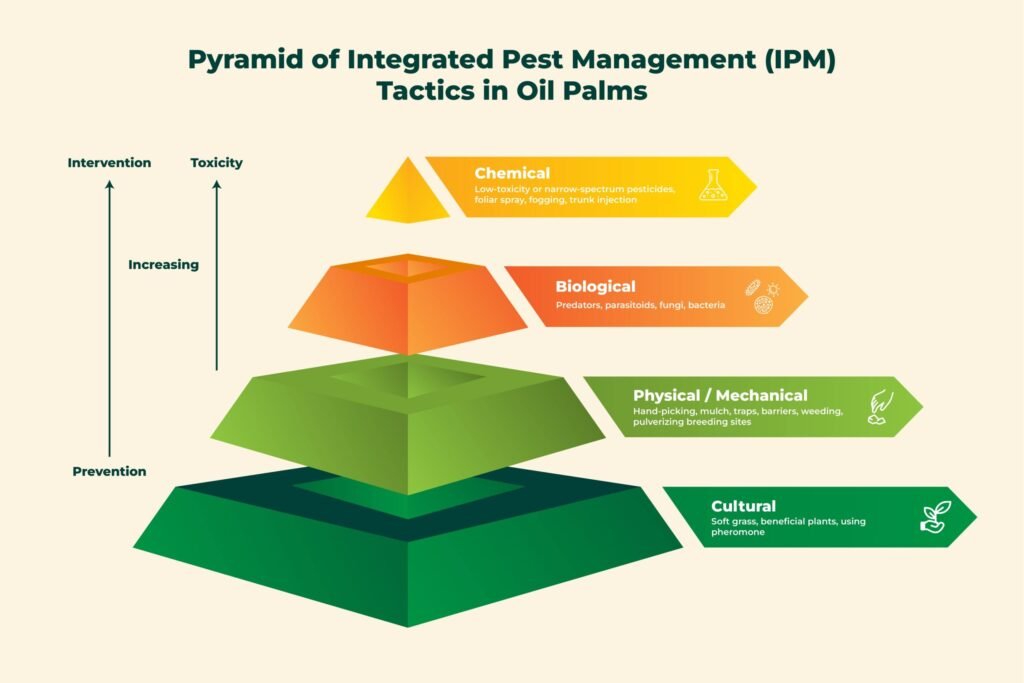
Summary of Contents
Introduction
Pests are every farmer’s nightmare. But instead of relying on harmful chemicals, Integrated Pest Management (IPM) offers a sustainable, environmentally-friendly way to control pests while minimizing damage to crops. On my farm in Northeast India, IPM has been key to keeping crops healthy without the side effects of conventional pesticides. Let’s dive into how IPM works, why it’s important, and how it can help your farm too!
What is Integrated Pest Management (IPM)?
Integrated Pest Management (IPM) is a sustainable approach to controlling pests by combining biological, physical, and chemical methods to reduce pest populations. Instead of relying solely on pesticides, IPM focuses on understanding the pest’s life cycle and using a variety of strategies to manage them effectively while minimizing environmental damage.
In simple terms, IPM is about using the right tool for the right job, whether it’s introducing beneficial insects to eat pests, using traps, or carefully applying pesticides only when absolutely necessary.
Step 1: Monitor and Identify Pests
The first step in IPM is scouting your fields to identify which pests are causing problems. Not all insects are harmful, so it’s important to know what you’re dealing with. You can use sticky traps, visual inspection, or even sensors to monitor pest activity.
On my farm, we regularly check crops for pests like aphids or caterpillars and track their population over time. This helps us decide when and how to act before things get out of control.
Step 2: Set Action Thresholds
Once you know which pests are present, the next step is to determine an action threshold—the level at which pest damage becomes significant enough to warrant action. This helps you avoid unnecessary interventions and only use control methods when needed. For example, if you see a few aphids, it’s not a problem, but if their numbers increase rapidly, it’s time to take action.
Step 3: Apply Control Methods
In IPM, there are several types of pest control methods, and the goal is to use the least harmful option first. Here’s a quick breakdown:
- Biological Control: Introduce natural predators like ladybugs or parasitic wasps to control pest populations.
- Cultural Control: Rotate crops, adjust planting times, or use pest-resistant varieties.
- Mechanical Control: Use traps, barriers, or hand-pick pests off plants.
- Chemical Control: Only when necessary, apply pesticides in a targeted and minimal way to avoid harming beneficial insects.
In Northeast India, farmers often use a mix of biological and mechanical controls, such as neem oil sprays and introducing beneficial insects like ladybugs to control pests naturally.

Benefits of Integrated Pest Management
IPM offers numerous advantages over conventional pest control. Here’s why it’s a good choice:
1. Environmentally Friendly
Because IPM uses multiple strategies to manage pests, it significantly reduces the need for harmful chemicals, protecting the soil, water, and beneficial organisms like pollinators.
2. Cost-Effective
By focusing on prevention and using pesticides only when necessary, IPM helps reduce costs associated with chemical inputs and crop losses.
3. Promotes Biodiversity
IPM encourages the use of natural predators and other biological methods that help maintain biodiversity on the farm.
Challenges of Integrated Pest Management
While IPM is highly effective, there are some challenges to consider:
- Time and Monitoring
IPM requires regular monitoring and scouting of crops to be successful. It’s not a “set-it-and-forget-it” approach—it demands attention to detail. - Knowledge and Training
Farmers need to understand pest life cycles and behavior to implement IPM effectively, which may require additional training.
Best Practices for Integrated Pest Management
Here are some tips to maximize the effectiveness of IPM on your farm:
- Scout Regularly
Keep a close eye on your crops and monitor for early signs of pest activity. Early intervention is key to preventing major damage. - Diversify Your Controls
Use a combination of biological, mechanical, and cultural methods to keep pests at bay. This will reduce the need for chemical interventions. - Minimize Chemical Use
When pesticides are necessary, apply them in a targeted way to reduce harm to beneficial insects and the environment.
Economic Insights: IPM Reduces Costs
Integrated Pest Management is not only good for the environment but also for your bottom line:
- Reduced Chemical Costs
With IPM, you’ll rely less on expensive chemical pesticides, saving money on inputs. - Higher Yields
Healthier crops mean better yields, which leads to more income. By controlling pests without harming the ecosystem, you ensure long-term productivity. - Fewer Crop Losses
By intervening early and using multiple pest control methods, IPM reduces crop losses and improves the overall health of your farm.
Conclusion: IPM for a Greener, Healthier Farm
Integrated Pest Management (IPM) is the smart way to protect your crops without harming the environment. By combining multiple strategies—biological, mechanical, and chemical—IPM offers a balanced, effective solution for pest control. Whether you’re managing a small garden or a large farm, IPM helps you stay one step ahead of pests while keeping your crops, your wallet, and the planet happy.

FAQ Section
How does integrated pest management work?
IPM works by monitoring pest populations, setting action thresholds, and using a combination of biological, mechanical, and chemical controls to manage pests in a sustainable and eco-friendly way.
Why is integrated pest management important?
IPM is important because it reduces reliance on chemical pesticides, protects the environment, and promotes biodiversity while effectively managing pest populations.
What does integrated pest management mean?
Integrated Pest Management (IPM) means using a variety of pest control methods—biological, mechanical, and chemical—in a balanced way to minimize environmental impact and effectively manage pest populations.
